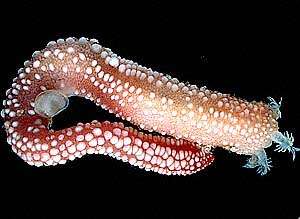
Sea cucumbers
PHOTO
The temperate holothurian Taeniogyrus australianus, Long Reef, Sydney, New South Wales, October 1977.
Photo: Bill Rudman.
Sea Cucumbers are Echinoderms, related to Starfish, Sea Urchins and Brittle Stars. They are placed in the Class Holothuria, and so are often called holothurians. They feed by collecting fine organic particles which form a layer on the sea bottom, with the ring of feathery oral tentacles which encircle their mouth. In the tropics Sea Cucumbers are collected, the gut removed and the skin dried for food. In this condition they are known as beche de mer (bêche de mer), trepang and sometimes sea slugs.
See Bohadschia graffei juvenile - a potential holothurian mimic of the nudibranch Phyllidia varicosa.
Authorship detailsRudman, W.B., 1998 (June 18) Sea cucumbers. [In] Sea Slug Forum. Australian Museum, Sydney. Available from http://www.seaslugforum.net/find/seacusec
Related messages
Sea Cucumber not Nudibranch
April 9, 2010
From: Andrew J Seaman
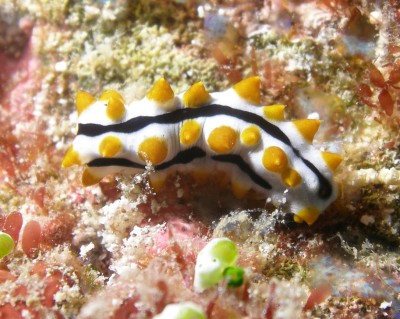
Dear Bill
I have taken a picture of what I believe to be a Nudibranch but can't establish an Identity. The picture was taken in the Maldives, North Ari Atol Himendhoo Thila in March this year.
The picture shows that this species has no median /nmidline ridge but has two rows of yellow tubercles on white body seperated by black stripes.
Help with indentification would be appreciated
Locality: Himendhoo Thila, North Ari Atol, 12 -15m, Maldives, Indian Ocean, 03 March 2010, Towards top of thila reef on outside.. Length: 30-40mm best estimate. Photographer: Andrew J Seaman.
Andrew J Seaman
andrew@flseaman.co.uk
Seaman, A.J., 2010 (Apr 9) Sea Cucumber not Nudibranch. [Message in] Sea Slug Forum. Australian Museum, Sydney. Available from http://www.seaslugforum.net/find/23438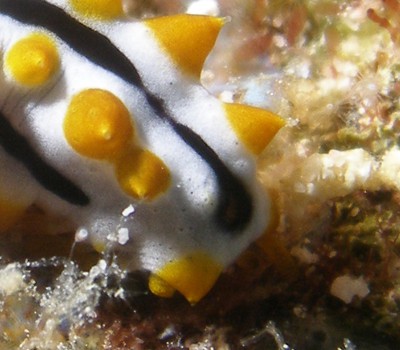
Dear Andrew,
This animal does look very like a phyllidiid, such as Phyllidia varicosa, but is in fact a juvenile sea cucumber. Its name is Bohadschia graeffei [or perhaps Pearsonothuria graeffei], and if you look at messages on the Sea Cucumber Fact Sheet you will see it only has the Phyllidia colouration when it is small.
Best wishes,
Bill Rudman
Sea slug of a non-mollusc kind
March 3, 2008
From: Bob Ahrens
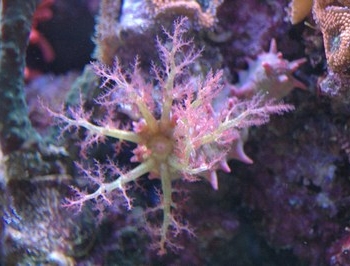
I got this wonderful 3 inch slug at my local reef supplier. I don't know where he got it from. It has an incredible way of feeding, involving "licking" its frondy fingers!
Locality: ?, ?, ?, ?, Length: 3 inches. Photographer: Bob Ahrens.
Thanks!
Bob Ahrens
rgahrens@yahoo.com
Ahrens, R.G., 2008 (Mar 3) Sea slug of a non-mollusc kind. [Message in] Sea Slug Forum. Australian Museum, Sydney. Available from http://www.seaslugforum.net/find/21199Dear Bob,
Just a very quick answer. This is a sea cucumber not a sea slug. The branching tentacles around its mouth are indeed its feeding organs. Have a look at the Fact Sheet and the attached messages for further information
Best wishes,
Bill Rudman
Sea slug from Egypt
February 15, 2008
From: Andrzej Jankowski
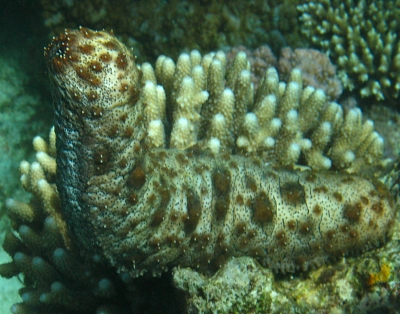
Could you please help me identify the sea slug below?
Locality: Sharm el Sheikh, 2 meters, Egypt, Red Sea, 27 november 2007. Length: 300 mm. Photographer: Andrzej.
Thanks.
ajankows@yahoo.com
Jankowski, A., 2008 (Feb 15) Sea slug from Egypt. [Message in] Sea Slug Forum. Australian Museum, Sydney. Available from http://www.seaslugforum.net/find/21235Dear Andy,
This is a sea cucumber rather than a sea slug. Have a look at the Fact Sheet and attached messages for more information
Best wishes,
Bill Rudman
Phyllidiid mimic from Nth Sulawesi
May 30, 2007
From: Mirjam Broos
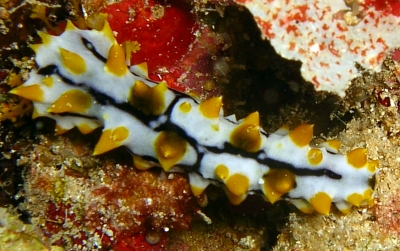
Dear Bill,
Another species I can't identify. My guess it is some kind of Phyllidiidae. But I didn't find a picture like this one.
Locality: Tanjung Pagiri, Bunaken, max 15 metre, North Sulawesi, Indonesia, Cellebes Sea, 03 october 2006. Length: ?. Photographer: Geert Prast.
Mirjam Broos
mirjam.broos@planet.nl
Broos, M., 2007 (May 30) Phyllidiid mimic from Nth Sulawesi. [Message in] Sea Slug Forum. Australian Museum, Sydney. Available from http://www.seaslugforum.net/find/18962Dear Mirjam,
You seem to have found a number of non nudibranchs which look suspiciously like them. This animal does look very like a phyllidiid, such as Phyllidia varicosa, but is in fact a juvenile sea cucumber. Its name is Bohadschia graeffei [or perhaps Pearsonothuria graeffei], and if you look at messages on the Sea Cucumber Fact Sheet you will see it only has the Phyllidia colouration when it is small.
Best wishes,
Bill Rudman
Grand Cayman Nudibranchs ?
September 1, 2006
From: Brian Mayes
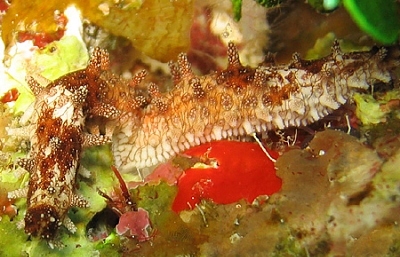
Hi Bill,
I hope you can't help with identification of these critters, which I presume to be nudibranchs. I found the two in what could be a mating position, on Neptune's Reef, Grand Cayman
Locality: Island, 10 to 15 metres, Grand Cayman, Carribean, 8 November 2005, Reef. Length: 2 to 3 inches. Photographer: Brian Mayes.
Best Regards
Brian Mayes
brian@mayescai.freeserve.co.uk
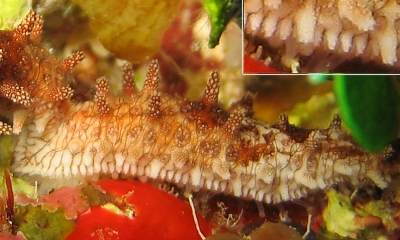
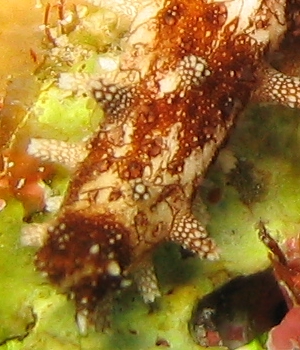
Dear Brian,
I am pretty sure these are not nudibranchs but some strange holothurian or sea cucumber. The one on the right seems to have a flattened base and does look a bit like a slug, But the flattened side is covered in small 'legs' which I guess are modified tube feet. The one on the left of your photo has a more typical cylindrical 'cucumber' shape and seems to have a ring of feeding tentacles [gills] at the end nearest the bottom of the photo.
Best wishes,
Bill Rudman
Sea Cucumber from North Carolina, USA
August 18, 2006
From: Nancy Undercoffer
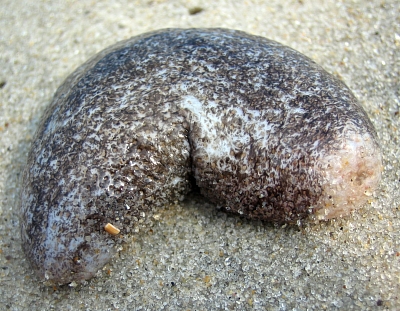
Vacationing in the Outer Banks, North Carolina, we were walking on the beach at low tide and happened upon several of these. One was in a "relaxed state" when I first saw it, part of it looking like a leopard spotted slimy mass, and when touched contracted into a hard ball (albeit slowly). In the pictures they are sort of in between (had relaxed slightly when left untouched). When pressed, it squirted water. We have been Outer Banks visitors for 15 years and had never seen one of these before. No one we asked could help us ID these. Can you please help to identify?
Locality: Salvo (oceanside,Outer Banks), North Carolina, Atlantic, 08 August 2006, Ocean beach, low tide. Length: 2 - 3 inches. Photographer: Nancy Undercoffer.
Nancy Undercoffer
leviu@comcast.net
Undercoffer, N.W., 2006 (Aug 18) Sea Cucumber from North Carolina, USA. [Message in] Sea Slug Forum. Australian Museum, Sydney. Available from http://www.seaslugforum.net/find/17501Dear Nancy,
Sometimes mistakenly called 'sea slugs', this is a Sea Cucumber. Despite their cucumber shape, they are close relatives of sea stars and sea urchins. I guess they live just offshore and may have been washed up after a storm.
Best wishes,
Bill Rudman
Trying to identify this giant slug species.
July 14, 2006
From: Walter D'Alonzo
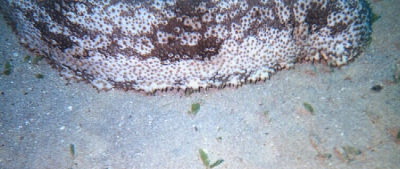
I'm trying to identify the slug species in this picture. I realize that it isn't a great photo, so I will provide some additional information. My dive buddy and I found these slugs all over the sea floor in sandy, flat areas. They seemed to be inhaling sand and filtering it. They were radially symmetrical and cylindrical with no obvious protrusions. They didn't respond when picked up, though they were obviously alive. There were two variations, one was predominantly white with contiguous dark grey splotches, as pictured, while the other slugs were identical but were predominantly dark grey with white splotches. Any help would be appreciated in ID'ing these creatures. I wasn't able to find anything similar in your species list.
Locality: Island, 30-50 feet, Runaway Bay, Jamaica, Atlantic Ocean, Mid June 2006, sandy bottom. Length: Appx. 1 foot. Photographer: Stephen Werner.
Walter D'Alonzo
wmdalonz@gmail.com
D'Alonzo, W.M., 2006 (Jul 14) Trying to identify this giant slug species.. [Message in] Sea Slug Forum. Australian Museum, Sydney. Available from http://www.seaslugforum.net/find/17089Dear Walt,
These are 'sea slugs' only in a very general sense. The true sea slugs are all molluscs - snails that have either lost their shells in their evolution, or are in the process of doing so. Your 'sea slugs' are more commonly called 'sea cucumbers' and the radial symmetry you describe is a clue to their real relationship, which is to sea stars and sea urchins and other echinoderms, which all show radial symmetry.
Best wishes,
Bill Rudman
Sea cucumber from Turks & Caicos Ids
July 29, 2005
From: Martin Banford
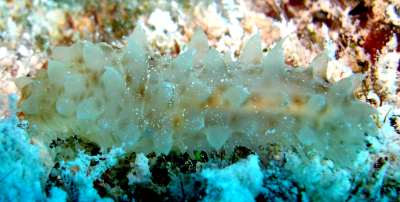
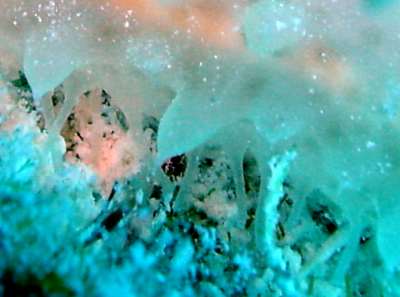
I wonder if you would be so good as to help me identify this little chap. Spotted him yesterday wandering up the side of a coral head very much in the manner of how a caterpillar moves, so he was compressing and streching from 4cms to about 6cms. It is not too obvious from the first photo, but there are a mass of little legs underneath him.
Locality: Sandbore Channel, Turks & Caicos Islands. Tropical West Atlantic. Depth: 13 m. Length: 4 cm - 6 cm. 24th July 2005. Coral head. Photographer: Martin Banford
Thanks very much.
Martin Banford
caicosbeachbum@hotmail.com
Banford, M., 2005 (Jul 29) Sea cucumber from Turks & Caicos Ids. [Message in] Sea Slug Forum. Australian Museum, Sydney. Available from http://www.seaslugforum.net/find/14425Dear Martin,
This is a sea cucumber or holothurian. They are echinoderms, closely related tp starfish and sea urchins. Like all echinoderms they use their tube feet for 'walking' - as well as other things I mention on the Fact Sheet. Your animal is possibly a juvenile of something that grows to 30 cms or more.
Best wishes,
Bill Rudman
What is this?
July 5, 2005
From: Jeremy Wood
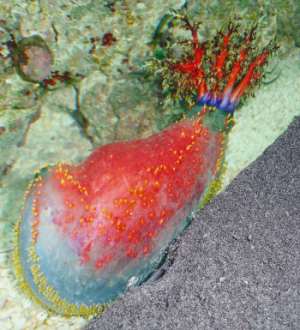
I got a picture of this thing at Sea World in San Antonio, USA. I have no idea what it is. Can you identify it?
Length: 30 cm? Photographer: Jeremy Wood
Jeremy Wood
qcotms@aol.com
Wood, J., 2005 (Jul 5) What is this? . [Message in] Sea Slug Forum. Australian Museum, Sydney. Available from http://www.seaslugforum.net/find/14187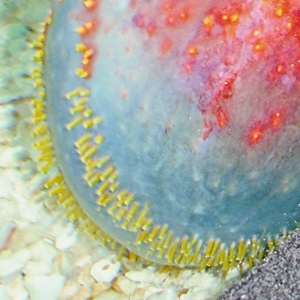
Dear Jeremy,
This is a sea cucumber or holothurian. Some species which are collected for food [beche de mer, trepang] are unfortunately called sea slugs but they are unrelated to nudibranchs and other opisthobranchs. Sea Cucumbers are echinoderms, which also include starfish and sea urchins. One clue to its identity are the two rows of tube feet which you can see in the close-up alongside. Usually these have suckers at their tips and are used for 'walking'. This is a very spectacularly coloured species named Pseudocolochirus violaceus.
Best wishes,
Bill Rudman
Unknown creature
March 16, 2004
From: Pamela
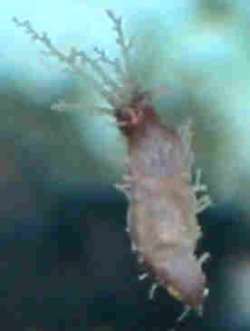
Hi all,
I've come across an unknown creature in my tank, and I have been referred to this site as it's been thought to be some kind of slug. Does anyone happen to know what it is?
Thanks in advance.
Pam
wiggleris@rogers.com
Pamela, 2004 (Mar 16) Unknown creature . [Message in] Sea Slug Forum. Australian Museum, Sydney. Available from http://www.seaslugforum.net/find/12451Dear Pam,
This is a sea cucumber or holothurian. Definitely slug-like but more related to starfish than molluscs. It shouldn't cause problems in your tank because it uses the tentacles you can see in your photo to pick up detritus and small organic particles that it feeds on
Best wishes
Bill Rudman
Sea Slugs spawning?
March 11, 2004
From: Dave Lyons
Hi, today, 11 March 2004, I had the opportunity to go on a school excursion with my daughter to the mangrove sand flats (intertidal,low tide) in Mackay Queensland. We found a sea slug (black about 5 inches long and similar shape to a cucumber), it was semi buried in the sand under oyster covered rock. Upon examination the slug promptly gave birth?, to a mass of white worm like larvae?, these were attached by a short narrow cord to a bubble not unlike that of a bluebottle jellyfish except it(the bubble) being absoloutly clear.
It was definately an experience my daughter will never forget, (it happened in her hand, and was promptly returned to the water) I was suprised as i had assumed that sea slugs would lay eggs or larvae in a secluded crevice, not float them out to sea as the action implied, any info would be appreciated as i will forward it to the school.
thanks,
Dave Lyons
djlyons1@bigpond.com
Lyons, D., 2004 (Mar 11) Sea Slugs spawning?. [Message in] Sea Slug Forum. Australian Museum, Sydney. Available from http://www.seaslugforum.net/find/12437Dear Dave,
What you found was not a sea slug but a Sea Cucumber, also known as holothurians, which are closely related to sea urchins and starfish. Some of these animals when 'frightened' can shoot out all their internal organs, which include a whole set of sticky white tubes as your describe. The process is called evisceration. The idea is that whatever animal is causing the problem, such as a fish, will either concentrate on eating the bits that have been shot out, or be upset by the sticky mass and go away. Amazingly, in a few weeks the sea cucumber can grow a new set of internal organs.
Best wishes
Bill Rudman
Re: 'Sea Cucumbers' in Korea
November 18, 2002
From: Richard Collins
Re: Message asking about "kaybuhl" in Korea. Kae-Bul are priapulid worms, and fit exactly the description you give. Pusan is one of the few places where they're eaten as a pretty regular dish. They're not unlike certain tipes of tripe, fairly chewy, with a marine tang. Pregnant women are known to favour them in hope of having a son.
Richard Collins
richardc@friendsofed.com
Collins, R., 2002 (Nov 18) Re: 'Sea Cucumbers' in Korea. [Message in] Sea Slug Forum. Australian Museum, Sydney. Available from http://www.seaslugforum.net/find/8440Dear Richard,
Thanks for solving what a Sydney newspaper columnist calls 'one of lifes little mysteries'.
Best wishes,
Bill Rudman
'Sea Slugs' but not Sea Slugs
June 30, 2002
From: Edy Budiman
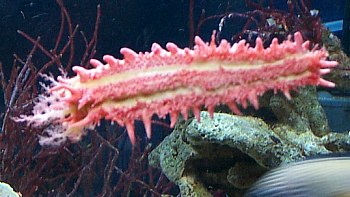
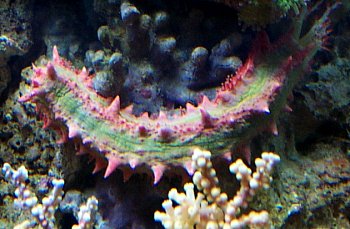
Dear Bill,
I need your help to identify these new sea slugs I just got. I attach two pictures here of the two sea slugs. They both have what it seemed like feeding tentacles at the tail/head. What's the species name? Are these reef-safe? What's the proper food? Compared to Jorunna funebris, they don't seem to walk a lot. They prefer to stick on the glass or the rock all the time.
I look forward to hearing from you soon.
Thanks in advance,
Edy Budiman
webmaster@tropicalwares.com
Budiman, E., 2002 (Jun 30) 'Sea Slugs' but not Sea Slugs. [Message in] Sea Slug Forum. Australian Museum, Sydney. Available from http://www.seaslugforum.net/find/7385Dear Edy,
These are Sea Cucumbers or Holothurians. Have a look at that page for some background information. Basically they are slug-like but not true slugs. They are echinoderms, closely related to starfish and sea urchins. I don't see why they shouldn't do well in an aquarium as they feed on detritus and fine organic particles.
Cheers,
Bill Rudman
Fact or Fiction
June 6, 2002
From: B. Michael
Dear Dr. Rudman,
Could you please resolve an ongoing disagreement? This question is a bit bizzare, but true. Is it fact or fiction there is a species of Goby fish which lives within the anus of a Sea Cucumber? (or possibly a Sea Slug?) If so, what is the name of this fish?
Thank you,
B. Michael
get_hooked@hotmail.com
B. Michael, 2002 (Jun 6) Fact or Fiction. [Message in] Sea Slug Forum. Australian Museum, Sydney. Available from http://www.seaslugforum.net/find/7163Dear B. Michael,
There are a group of fish which live at least some of their lives in the anus of holothurians - believe me I've seen them!
They are not gobies but a specialised group of the family Carapidae, commonly called Pearlfishes. I can't tell you much about them, except that the ones I saw were about 15cm long. The name should help you search out some more information.
Best wishes,
Bill Rudman
Please help with this ID
January 18, 2002
From: Matt Rains
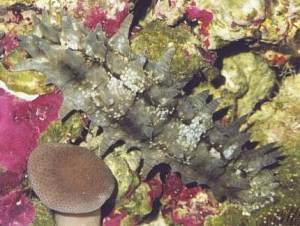
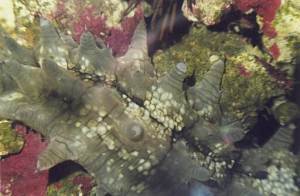
I would like some help in identifying this critter. It has been in my tank for 8 months. I suspect that it arrived on some live rock that i purchased around the same time i first saw it.
The first time i saw it the body measured 5cm long and was semi-transparent. At the time the photographs were taken last week the body measured 18cm long and 4.5cm wide. It is no longer semi-transparent.
It only comes out at night. I have seen it on the sandbed, reef and also the glass. As it has become larger it has begun to explore more. The anus(?) is sensitive to light. The rest of the body including the head(?) is not. I live in Adelaide, South Australia but the i assume the live rock came from Queensland. I could find out at the LFS if this helps.
Thanks,
Matt
matt@mattshouseofpain.com
Rains, M., 2002 (Jan 18) Please help with this ID. [Message in] Sea Slug Forum. Australian Museum, Sydney. Available from http://www.seaslugforum.net/find/6014Dear Matt,
Your animal is a Sea Cucumber (Holothurian) which you'll see from the Fact Sheet and other messages on this page are related to Starfish and Sea Urchins. Sea Cucumbers have a circle of sticky branching tentacles around their mouth which they use to collect up organic particles, which they eat, from the surface of the sand and rocks. Your animal is clearly very happy in your tank and is probably doing a useful job as a living vacuum cleaner. I am not sure of its identification but it looks as though it could be a species of Stichopus.
best wishes,
Bill Rudman
Mystery from the Maldives
September 23, 2001
From: John Chuk

Dear Bill,
I'm in need of help once again! This 20mm specimen was photographed at Fulidu West Kandu, Felidu Atoll, in the Maldives on 21 Sept. 1993. It was found at a depth of 15m. It was stationary and I was unable to observe rhinophores. I have no idea what it may be. Any help would be appreciated!
Best wishes,
John
jchuk@giant.net.au
Chuk, J., 2001 (Sep 23) Mystery from the Maldives. [Message in] Sea Slug Forum. Australian Museum, Sydney. Available from http://www.seaslugforum.net/find/5143Dear John,
I suspect this is a holothurian or Sea Cucumber. If not, I have no idea what it is.
Cheers,
Bill Rudman
Re: Sea Slug from Alaska?
June 29, 2001
From: Kathryn McDonald
Dear Bill,
Thank you so much for your reply. We brought the creature home in a bucket and have been able to observe it more closely. Having had a look at the sea cucumber page you gave, I think that is what it is -- much more "sea star-like" than slug.
Thanks so much!
Kathy McDonald
kathrynb@gci.net
McDonald, K. , 2001 (Jun 29) Re: Sea Slug from Alaska?. [Message in] Sea Slug Forum. Australian Museum, Sydney. Available from http://www.seaslugforum.net/find/4694Sea Slug from Alaska?
June 28, 2001
From: Kathy McDonald
We live in Sitka, Alaska. This morning I took my sons down to the shore at -2.7 tide. At the edge of one of the inlets, I noticed what at first looked like an orange sea star's arm so I gently poked at with my stick thinking it would not move. But it did and then I noticed a rather large stoma on the topside. Not knowing really what sea slugs are (never having seen one) but never having seen anything like this creature before I told my sons I though it was a sea slug. Now I'm not so sure. It doesn't have any discernable antennae and is just one color. It's softer than a sea star. Do you have any idea what this is?
Thank you.
Kathy McDonald
kathrynb@gci.net
McDonald, K., 2001 (Jun 28) Sea Slug from Alaska?. [Message in] Sea Slug Forum. Australian Museum, Sydney. Available from http://www.seaslugforum.net/find/4674Dear Kathy,
I'm afraid that without more information - photo, drawing perhaps? I can't even guess. The only orange thing I been asked about from that part of the world would be a sea cucumber. Have a look at the following message. If it is that animal it is in fact a sea cucumber -see later messages on that page for a discussion on it
Otherwise I admit defeat
Best wishes,
Bill Rudman
Sea Cucumbers in Korea
June 16, 2001
From: S. Katcher
I was recently in Pusan, Korea. On the beach there, there were a number of sea animals in tanks outside of small fish eateries. One animal was a pink-colored, tube-like, seemingly hollow form of at least 12 inches that undulated in the tank. It had no eyes or other obvious sensory features that I noticed (although I assume it had sense organs somewhere). It seemed to have an opening at one end. It reminded me of a long party balloon, except instead of having the balloon knotted at one end to keep the air in, there was just an opening.
The people we were with said that in Korean the animal is called "kaybuhl." In Japan, we were told that there is a smaller version of the animal called "namako." When we looked up the definition of the words, the English translation was "trepang" and "a sea cucumber." I do not think the animal we saw was a sea cucumber, however.
Is anyone familiar with this particular species that I have described? Can you refer me to a book or other source that would have a photograph?
Thank you.
S. Katcher
s_katcher@hotmail.com
Katcher, S., 2001 (Jun 16) Sea Cucumbers in Korea. [Message in] Sea Slug Forum. Australian Museum, Sydney. Available from http://www.seaslugforum.net/find/4578Dear S. Katcher,
There are different sorts of sea cucumbers, some hard and leathery others soft with waves of muscle contrcations down their bodies which would fit your description of undulating. I don't know the Korean word but the Japanese 'namako' is a sea cucumber. If you have a look at a page on the Nagasaki Marine Lab ebsite you will see a set of photos showing the gutting process that occurs before the animal is dried for storage.
http://www.marinelabo.nagasaki.nagasaki.jp/kakou/hiraki/namako.html.
I am not an expert on these animals however and only tolerate them on the Sea Slug Forum because they are sometimes called 'sea slugs'.
Best wishes,
Bill Rudman
What is a 'bêche de mer'
April 6, 2001
From: Geoff Brady
I'm not sure I'm in the right place, but I'm trying to find out about a thing called (and I'm not sure about the spelling) a "beach de mer". Can anybody tell me how to spell it and where i can find some info about it please.
Thanks,
Geoff Brady
gbrady@provet.net.au
Dear Geoff,
It's not really the right place but because these animals are sometimes called 'sea slugs' I have got a page on them. Have a look at the top of the page.
The word bêche de mer is a French word referring to the way they crawl across the sea bottom 'eating' the sand and silt to remove the organic particles they feed on. [Bêche = spade and bêcher = to dig in French, and 'de mer' = of the sea.]
As you'll see at the top of the page these animals are also called 'sea cucumbers', for obvious reasons, and the Malay / Indonesian word for them is 'trepang'. They are related to sea stars and sea urchins. There is quite a fishery for some species in the tropics, the dried carcase being used in south east Asian cooking.
Best wishes,
Bill Rudman
Re: Nudibranch?
September 7, 2000
From: Dave Behrens
Hi Bill:
I think Mary's critter is the sea cucumber, Psolus squamata.
Dave Behrens.
dave@seachallengers.com
Behrens, D., 2000 (Sep 7) Re: Nudibranch?. [Message in] Sea Slug Forum. Australian Museum, Sydney. Available from http://www.seaslugforum.net/find/2974Thanks Dave.
Mary, have a look at the information on sea cucumbers above your message, and have look through the other messages below yours on this page to see what they look like and for =some basic information about them.
Best wishes,
Bill Rudman.
Nudibranch?
September 6, 2000
From: Mary Arroyo
Hi,
I was diving at Casino Point on Catalina Island over the weekend and saw what I thought was a nudibranch, but there were no outer frills that I could tell. It was probably about an inch long, was sort of a dull reddish brown with tiny blue spot in two rows down it's back, and its head was blunt. If you can, please let me know if this was a nudibranch or sea slug, and where I can find a picture of it. I have looked at a few sites, but all the photos of nudibranchs show the frills.
Thank you,
Mary Arroyo
mark64@deltanet.com
Arroyo, M., 2000 (Sep 6) Nudibranch?. [Message in] Sea Slug Forum. Australian Museum, Sydney. Available from http://www.seaslugforum.net/find/2914Dear Mary,
I guess the Catalina Island you mention is in California, but even thought the World Wide Web brings us closer together, the world is still a very big place, so a few geographic clues is always a help.
I'm afraid I can't place your animal. I am not sure what you mean by 'frills'. Some nudibranchs such as aeolids have 'frilly' cerata down each side of the body, and others such as tritoniids have 'frilly' gills down each side of the body. Dorids on the other hand, of which there are many species, have a 'frilly' circle of gills at the posterior end of the mantle, but don't usually have frills down each side. Have a look at the gills of a large species of Glossodoris and the page on the dorid head for an idea of the shape of a dorid.
Did your animal look like any of these in general shape? basically I thnk I would need a picture, photo, drawing etc before I could help much more.
Best wishes,
Bill Rudman.
Mystery from Florida, USA
July 14, 2000
From: Mark Franey
While diving at a depth of 50', on a sandy bottom next to a ledge, in the Tampa Bay area of Florida, I observed a slug like critter that looked mostly off-white with brown blotches crawling on the bottom filtering the sand, I assume, for food. It was catapillar like, and couldn't swim. It was about 10" long and 3" in diameter. What do you call it? What do they eat?
Mark Franey
mark_franey@jabil.com
Franey, M., 2000 (Jul 14) Mystery from Florida, USA. [Message in] Sea Slug Forum. Australian Museum, Sydney. Available from http://www.seaslugforum.net/find/2712Dear Mark,
You don't give me many clues, but from its length, and 'caterpillar like' body, you probable saw a Sea Cucumber.
Have a look at the Sea Cucumber Page for a photo of a sea cucumber. The most noticeable feature would have been a circle of feathery feeding tentacles at one end, which are used to collect its food - minute organic particles which form a thin layer over the sand and mud on which it lives. There is also a photo in a message from the Mediterranean of a sea cucumber which sounds somewhate similar to your description.
Sea Cucumbers are close relatives of Starfish and Sea Urchins.
If it didn't look like a sea cucumber then you will need to send me a drawing or photo, so I have a few more clues.
Best wishes,
Bill Rudman.
Sea cucumbers of the Azore Islands
July 1, 2000
From: Denise Merys
My husband works in the cable industry, laying and repairing cable along the sea bottom and coastal shores all over the world. He discovered a healthy population of sea cucumbers along the coastal waters off the Azore Islands in about 30 feet of depth. Could you possibly tell us what type of cucumbers these might be? Unfortunately I do not have a picture to provide.
Denise Merys
Denmerys@aol.com
Merys, D., 2000 (Jul 1) Sea cucumbers of the Azore Islands. [Message in] Sea Slug Forum. Australian Museum, Sydney. Available from http://www.seaslugforum.net/find/2642Dear Denise,
I'm afraid Sea Cucumbers are outside the Forum's area of expertise. Hopefully someone visiting the Forum will have a friend or colleague or can help you.
Best wishes,
Bill Rudman.
Re: mystery animal from NE Pacific
June 2, 2000
From: Dave Behrens
Hi Bill:
Gary's critter is definitely a cucumber. It is Cucumaria miniata, very common along this entire coastline.
Dave Behrens
dave@seachallengers.com
Behrens, D., 2000 (Jun 2) Re: mystery animal from NE Pacific. [Message in] Sea Slug Forum. Australian Museum, Sydney. Available from http://www.seaslugforum.net/find/2490Thanks Dave,
Glad to have that solved
Bill Rudman.
Re: Ascidian or Sea Squirt
June 1, 2000
From: Gary Ouellette
Bill,
Concerning your question. He was hanging down, stretched out to over 7 inches. The pic was somewhat of a horizontal shot. When I touched it she started to pull into a fatter thicker body. There were only two of these things in this area, both about the same size.
Thanks,
Gary
ouellettegj@home.com
Ouellette, G., 2000 (Jun 1) Re: Ascidian or Sea Squirt. [Message in] Sea Slug Forum. Australian Museum, Sydney. Available from http://www.seaslugforum.net/find/2485Dear Gary,
I think I would go for the Sea Cucumber identification.
Best wishes,
Bill
Re: mystery animal from NE Pacific
May 30, 2000
From: Gary Ouellette
Thanks Bill for posting my question. In the posting you think it's a ascidian, but in the e-mail I received from Robert A. Koch, Ph.D., he says it's not. (Department of Biological Science, Cal State Fullerton, P.O. Box 6850, Fullerton, CA: rkoch@fullerton.edu)
Koch writes "I am not an expert on marine invertebrates. I can tell you that it is not an ascidian. Here are the comments of a colleague. Roger Seapy... "The longitudinal rows of dark structures on the side of the body almost certainly are tube feet - which makes this animal a sea cucumber. If my memory serves me correctly, it very well could be Cucumaria miniata.
Hope this helps."
So, I guess I'm still searching because it does not look like a sea cucumber either.
Thanks for your help anyway.
Gary.
PS. The next chance I get I'm going back out to take more pics of this thing.
ouellettegj@home.com
Oellette, G., 2000 (May 30) Re: mystery animal from NE Pacific. [Message in] Sea Slug Forum. Australian Museum, Sydney. Available from http://www.seaslugforum.net/find/2477Dear Gary,
Nothing like a good mystery. It looks to me like something which a marine biologist from your part of the world would recognise quite easily. Hopefully one of them will contact us.
I didn't even bother mentioning that it looked like a holothurian or Sea Cucumber because they do not usually live exposed on intertidal rocky shores, and certainly don't live attached at one end like your animals seem to be doing. I still think a Sea Squirt is a good possibility and next time you are back, check to see if they attached at on end, and if so, see if they have two openings (siphons) etc and whether they squirt out some water when gently squeezed.
In the meantime let's hope someone who is familiar with the fauna will let us know what they are.
Best wishes,
Bill Rudman.
Re: NE Pacific mystery animal again
May 30, 2000
From: Bill Rudman.
Dear Gary,
At the risk of having a long debate with myself about your animal, I found a couple of books with descriptions, but not good pictures, of the Sea Cucumber Cucumaria miniata. It certainly seems that your animal could be that. On looking at your photos again I realise that I have been assuming that your pictures were of a vertical surface, so that it appeared the mystery animal was hanging from an attachment point at the top, but if your photo is of a horizontal surface then it could easily be Cucumaria miniata just lying there waiting for the tide to return. Cucumaria certainly grows to the size of your animal.
Let me know if your photo is of a vertical or horizontal surface. If the latter, I'll move your beast to the Sea Cucumber Page. Perhaps I should just stick to slugs!
Best wishes,
Bill Rudman.
Is this a sea slug?
May 26, 2000
From: Gary Ouellette
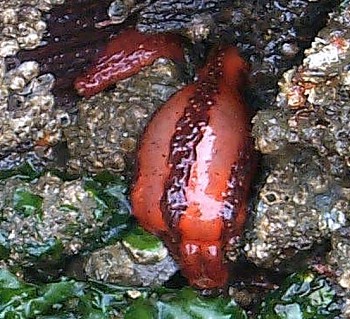
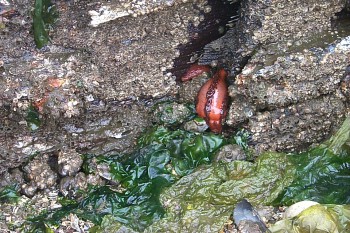
Sir,
Is this some type of sea slug? I found it hanging from an old ship hull wreck in the Nisqually Delta Basin, Nisqually, Washington, USA.
It was hanging down over 8 inches before I touched it and it started to curl up.
Thanks for your help.
Gary Ouellette
Sergeant Major, US Army
Fort Lewis, WA
USA
ouellettegj@home.com
Ouellette, G., 2000 (May 26) Is this a sea slug?. [Message in] Sea Slug Forum. Australian Museum, Sydney. Available from http://www.seaslugforum.net/find/2442Dear Gary,
Did it squirt out some water when you touched it. I am pretty sure that your animal is an ascidian or Sea Squirt, quite unrelated to slugs. It seems to be attached to the rock at one end and has a pair of openings at the free end at the bottom of your photo.
I have posted a page on ascidians. Have a look at it for some background information. In that you will see that some ascidians are solitary animals and others live in sponge-like colonies. If I am right, your animal is one of the solitary species.
Best wishes,
Bill Rudman.
Mediterranean Sea Slug or Sea Cucumber?
May 10, 2000
From: Christian VALEZY
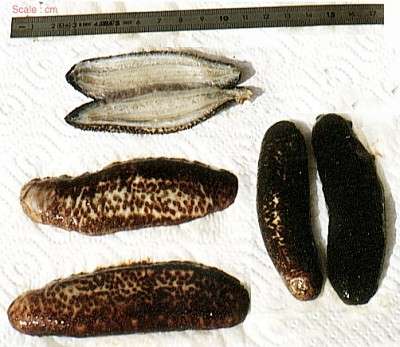
Sea slug or sea cucumber ?
I found this sample in Mediterranean Sea (depth: 30 cms on the sand ) but I don't know the scientific name of this one.
Thank you for helping me to know more about it.
All answers will be welcome.
Christian VALEZY
valezy@worldnet.fr
Valezy, C., 2000 (May 10) Mediterranean Sea Slug or Sea Cucumber?. [Message in] Sea Slug Forum. Australian Museum, Sydney. Available from http://www.seaslugforum.net/find/2375Dear Christian,
This is a Sea Cucumber [Holothurian]. If you go to that page and look at the messages there, you will find quite a lot of information about them.
I am afraid I can't identify the species of your holothurian, but it shouldn't be very difficult to do so from a book on the Mediterranean fauna.
Best wishes,
Bill Rudman.
Are sea slugs & sea cucumbers the same?
May 4, 2000
From: Mandy
My 6 year old daughter is doing a report on sea slugs and I was wondering if the sea slug and sea cucumber were the same animal?
Mandy
www.jlwkam@aol.com
Mandy, 2000 (May 4) Are sea slugs & sea cucumbers the same?. [Message in] Sea Slug Forum. Australian Museum, Sydney. Available from http://www.seaslugforum.net/find/2349Dear Mandy,
Sea Cucumbers are sometimes called Sea Slugs but they are not 'real' Sea Slugs.
If you look above your message, which I have put on the Sea Cucumber Page, there is a photo of a fairly typical sea cucumber, and if you look below your message, at the earlier messages on sea cucumbers, there is quite a bit of information on sea cucumbers.
Basically Sea Cucumbers are Echinoderms, related to Starfish and Sea Urchins. They feed by collecting fine organic particles which form a layer on the sea bottom, with their feathery tentacles which encircle their mouth. In the tropics Sea Cucumbers are collected, the gut removed and the skin dried for food. In this condition they are known as beche de mer, trepang and sometimes seaslugs.
'Real' Sea Slugs on the other hand, are snails that have lost, or are in the process of losing their shells. There are a couple of pages with some general background information on sea slugs [what is a slug?., what is a sea slug?].
Otherwise the whole of the Forum describes, discusses and displays sea slugs. For more general topics go to the blue Navigation Bar at the top and bottom of each page and click on the General Topics button which will take you to a list of general topics. On every page it is worth looking through any messages which are added to the bottom, as they often have more information and photos.
I hope this will help,
Best wishes,
Bill Rudman.
Sea Slugs & Sea Cucumbers
January 17, 2000
From: Carol Vogelman/Steve Peden
My friend and I are debating on the difference between sea slugs and sea cucumbers and he claims that they are two different things. Could you explain to me? We live in LA in Brentwood and my son found what he thought was a sea cucmber and now we don't know the difference. Steve, my fellow says that there are sea hares at Venice Beach under a bridge that are up to a foot long. What do you know about these?
Thank you for sharing this information!
Carol and Steve
stevenepeden@aol.com
Vogelman, C. & Peden, S., 2000 (Jan 17) Sea Slugs & Sea Cucumbers. [Message in] Sea Slug Forum. Australian Museum, Sydney. Available from http://www.seaslugforum.net/find/1740Dear Carol & Steve,
Have a look at the messages on the Sea Cucumber Page for some information on Sea Cucumbers, which are related to starfish and sea-urchins, and quite different from true Sea Slugs. There is also a Page discussing what is a Sea Slug. Sea Slugs are basically a group of marine snails which have either lost their shells or are in the evolutionary process of losing their shells.
Sea Hares are a particular type of Sea Slug. I am not an expert on Californian marine life, but one of the Californian species of Sea Hare, Aplysia vaccaria can grow to a metre in length. I would love to see a photo of such a big animal.
If you go to the list of General Topics you will find more information on these fascinating animals.
Best wishes,
Bill Rudman.
Nutritional facts about 'trepang'
March 30, 1999
From: Leevey
Hi, I come from Indonesia, we love to eat sea slugs, especially in a chinese restaurant. Every chinese restaurant here has many sea slugs, usually we eat them with abalone and shitake mushroom.Indonesian called them tripang.
I would like to know if they are fattening? Do they contain a lot of cholesterol? Basically I would like to know about the nutrition facts.
Thank you very much.
Please e-mail me.
Leevey.
Hendra88@indo.net.id
Dear Leevey,
As you will see if you look at the information at the top of this page, and the other messages below yours, 'trepang', 'beche de mer', 'sea cucumbers' are all names for a group of animals which are often called 'sea slugs' but are unrelated to true slugs which are molluscs (snails, clams, squid etc.) Sea Cucumbers or Holothurians are echinoderms (starfish, sea urchins, brittle-stars etc).
I'm afraid I know nothing about their nutritional value, or how much cholesterol they contain. I suggest you get advice from your doctor.
Best wishes,
Bill Rudman.
Economic values of sea cucumber
February 22, 1999
From: Sarah b. Garchitorena
Didier,
We are a students from Ateneo de Naga University taking up BS Biology, fourth year.
We wrote you hoping that you could give us information about the importance or the commercial value of sea cucumbers, because of its lack of studies.
Thank you very much.
Sarah B. Garchitorena
Philippines.
garchi_sarj1102@hotmail.com
Garchitorena, S.B., 1999 (Feb 22) Economic values of sea cucumber. [Message in] Sea Slug Forum. Australian Museum, Sydney. Available from http://www.seaslugforum.net/find/599Dear Sarah,
I am afraid this is a mollusc "Sea Slug" site. There is some information on a Sea Cucumber page I have added for questions such as yours. I suggest that you contact Didier, who sent us a message about Sea Cucumbers, directly at his email address: pulsar31@hotmail.com.
Best wishes,
Bill Rudman.
Sea Cucumber
December 14, 1998
From: Didier
Hi,
I am doing a research to raise Sea Cucumber and I will appreciate if someone can send me more details to the different procedures.
Cordially,
Didier.
pulsar31@hotmail.com
Dear Didier,
I'm afraid Sea Cucumbers are outside the scope of the Sea Slug Forum. You will find some information on them here (look at the other messages on this page) but for more detailed information you will need to search sites with information on holothurians (Phylum: Echinodermata). The SEARCH button at the top of this page (on the right above the sea cucumber photo) will take you to the Australian Museum Online search page. If you use one of the Search engines listed there you should find something. "Meta Crawler" is quite good because it uses a number of the major search engines simultaneously.
True Sea Slugs are marine snails which in evolutionary terms have lost or are losing their shells.
Best wishes with your research,
Bill Rudman.
sea cucumber
November 6, 1998
From: Mick Frederic
Hi
Hope you can provide me with some background information concerning sea cucumbers. I work and live in Mauritius in one of the biggest resorts on the island.
The resort has employed people to collect and displace sea cucumbers from close to the beach to further out.The resort considers the sea cucumbers as a nuisance but are still aware that they certainly have a role to play in the balance of things. I have not been able to find any information so far concerning the sea cucumbers.
The type being moved is brown in color with a lighter shade underneath, they seem to bury themselves in the sand and most of them "surface" some time in the afternoon- there are large numbers of individuals.
They produce white defensive mucus when handled but otherwise are totally harmless creatures. This type of sea cucumbers is only found in shallow water.
Thanks,
Mick Frederic
frederic@intnet.mu
Frederic, M., 1998 (Nov 6) sea cucumber. [Message in] Sea Slug Forum. Australian Museum, Sydney. Available from http://www.seaslugforum.net/find/289Dear Mick,
As you may have realised from the message below yours on this page, Sea-cucumbers, although "sluggy" are not really my area of expertise. However I lived in Tanzania for some years and are familiar with the populations of sea cucumbers which are sometimes found on the wide intertidal sandflats on sheltered shores of the western Indian Ocean. I had a number of attempts to identify it without great success but I am pretty sure it was a species of Holothuria, may be even Holothuria scabra.
One thing I would be wary of is trying to "pretty up" the environment by interfering with nature. The marine station I worked at was surrounded by tourist resort hotels and every new manager tried to do his bit to better nature .. and like King Canute they all failed, and usually caused damage.
Sea Cucumbers act much like earthworms, recycling the upper layers of sand and seemed to be particularly important in those intertidal sandflats. In years when their populations were low (natural fluctuations, people pressure etc) areas of the sandflats became deoxygenated just below the upper couple of millimeters and often a web of filamentous bluegreen algae covered the surface often with many small mussels embedded in it. I didn't mind it because it provided a habitat for tiny nudibranchs but it was visually and to walk over, a fairly unpleasant experience, especially to tourists walking out for a swim or a lie in the sun.
My advice would be to leave the sea cucumbers where they are..who other than the manager really cares or is offended by them?
If you would like to chat with a friend in Mauritius who could give you some background views and ideas on conservation etc, get in touch with Owen Griffiths Olgmas@bow.intnet.mu . He farms crocodiles, and is researching endemic landsnails in Mauritius and Madagascar, amongst other things. Although not a student of marine creatures he, as a landsnail expert, is well aware of how fragile most ecosystems can be.
Best wishes,
Bill Rudman.
Sea Cucumber secretions
June 18, 1998
From: Bruce Livett PhD
Dear Bill,
Following up the question by Andrea Stephenson about defence mechanisms, I would be interested in information (or sources) about the chemical nature of the defence secretions of sea slugs. When I was snorkelling with a Quicksilver marine biology "discovery trip" out from Port Douglas on the Great Barrier Reef some years back I was handed a large black sea slug (with white spots I think) by the marine biologist taking the trip and she handed it to me in such a way that I stimulated the secretory glands. The result was that my hands were covered with a thick gelatinous gooey solution which was quite warm. She then asked me to give the sea cucumber back to her and to hold my hands out of the water with my fingers closed tight to one another. In what seemed a very short period maybe 20 seconds) the gelatinous secretion covering my hands became very warm and within a couple of minutes had solidified into a hard white (somewhat elastic) glue which she had to use a pair of scissors to cut between my digits to allow me to move my fingers again. For days I was peeling off this white hardened substance from the hairs on my hands. What is the nature of this secretion? Does anyone know?
Bruce Livett PhD
University of Melbourne, 3052,
Parkville
Victoria, Australia
b.livett@biochemistry.unimelb.edu.au
Livett, B. PhD, 1998 (Jun 18) Sea Cucumber secretions. [Message in] Sea Slug Forum. Australian Museum, Sydney. Available from http://www.seaslugforum.net/find/151Bruce, unfortunately "sea slug" is a very ambiguous common name. Although to a malacologist a "slug" must be a mollusc, to many people "slug" is a generic term for anything soft and squishy and which exudes sticky or mucous secretions. Your "sea slug" is in fact a Holothurian or Sea Cucumber which are a class of Echinoderms related to Starfish and Sea Urchins. Many large tropical holothurians are collected and dried for food and known as Beche-de-mer or Trepang. Sea Cucumbers are an interesting parallel to opisthobranchs, both groups having lost the protection of the hard shell or exoskeleton found in their closest relatives. In both cases they have had to evolve other means to protect them from predation, and in both holothurians and opisthobranchs distasteful and sticky secretions are one of these means of protection. Unfortunately I don't know anything about the chemical nature of holothurian secretions. Probably the most comprehensive chemical review of opisthobranch secretions is Avila, 1995 which is listed under Sea Hares - attack & defence ... Bill Rudman.
Rudman, W.B., 1998 (Jun 18). Comment on Sea Cucumber secretions by Bruce Livett PhD. [Message in] Sea Slug Forum. Australian Museum, Sydney. Available from http://www.seaslugforum.net/find/151